Warm water floor
If you decide to lay the water floor with your own hands, let's say right away, this task is not simple, but in any case, you can cope with absolutely any task set before yourself, it is enough to be aware of how to implement it. If you have enough money to order installation from specialists, we recommend using their professional services. But during the crisis, when every penny is in the account, it is more expedient to use your forces. In this regard, the very topical issue is the possibility of creating a warm water floor with your own hands.
It should be noted right away that it is better to install warm water floors in a country or private house. The apartment is quite problematic to connect the system of the warm floor to the riser, and the very possibility of apartment owners in high-rise buildings appeared only with the beginning of the construction of the so-called "elite housing", where the project foresees a system of warm floors.
In a typical "Khrushchev" or a panel house, you probably will not get permission to install it, you can find out everything by contacting your ZHKO. It is quite another matter if you already use autonomous heating and decide yourself how and in what volume it is necessary to heat your apartment.
Floor arrangement
The warm floor type can be divided into two types:
- grazing;
- concrete.
The floor installation is divided into a wooden installation system and polystyrene, and concrete laying implies that the floor surface will be flooded with a concrete screed. The floor view differs from the concrete one in that all wet processes completely exclude, due to which the speed of work on installation of warm floors increases several times.
Installation of a warm floor
Before you start an independent installation of the warm floor, you need to read the maximum information. First, let's look at the possible systems for installing such a floor a little more.
Concrete floor heating system
In modern construction, such a system is the most common installation system, the pipeline contours are closed with concrete mortar and no additional heat separators are required.
The installation technique is guided by the following stages, which must be followed:
- Coating with insulating material of the rough surface;
- Installation of reinforcement mesh and installation of pipeline contours;
- Carrying out crimping of system works;
- Pouring of concrete solution;
- Clean flooring.
Separation of the room into plots
The room is divided into sections. The number of such sites will depend on the geometry and area of the room. The maximum area of one heated area should not be more than 40 m 2, in addition, the ratio of all sides of the room should be at least 1: 2. To markup, these requirements are due to the fact that the screed will expand significantly under the influence of temperature and, in order to get rid of the cracking of the concrete screed, this must be compensated.
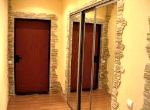
Surface coating with an insulating layer
On the previously cleaned base, it is necessary to put a heat-insulating layer. Due to such a heat-insulating layer, losses of heat radiated by the floor are not allowed. Heat will only go up in the heated room. At the device of a thermal protection in building various materials which are resolved for use for these purposes can be used. The most common building thermal insulation material is foam plastic. Should have such a thermal insulation layer thickness of up to 15 cm, depending on the thermal conditions of rooms and the amount of heat loss.
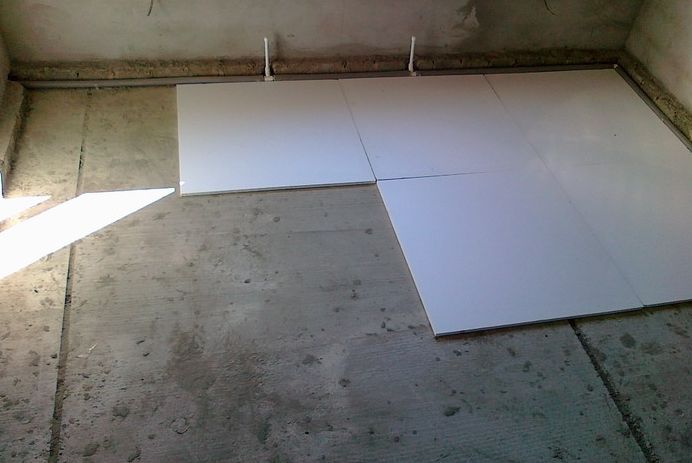
Between the sectors and around the perimeter of the room, a damper tape is required to serve to compensate for the thermal expansion of the concrete screed used. A polyethylene film is placed on top of the heat-insulating material.
Reinforcing mesh and pipeline installation
Lay the reinforcing mesh with the cross-section of the rod 0.4-0.5 cm, with a cell size of 15 × 15 cm. There is a possibility of double reinforcement, in which the second layer of the mesh is installed over the installed pipeline.

Next we begin the installation of the pipeline of a warm water floor. Depending on the project used, the pipeline is installed in steps of no more than 30 cm and the scheme for installing the pipeline contours is selected. With the help of special plastic clips we attach the pipeline to the reinforcing mesh, on the expansion joints a corrugated pipe is put on the pipeline to protect it from damage.

There are several standard schemes for laying out contours: a double snake, a spiral with a displaced center, a snake and an ordinary spiral. When laying the pipeline along the outer wall, it is necessary to reduce the distance between the pipes, in order to avoid temperature differences on the surface, the main part of the contour along the wall must pass. there is higher heat loss. The approximate flow rate of a pipeline per 1m 2 of surface mounted at a step of 20 cm is approximately 5 pm.
Pressing of floors of water
Upon completion of the installation work, it is necessary to press the system under operating pressure to detect mechanical damage.
Pouring of concrete solution
After crimping, concrete casting is poured, and the system must be kept under operating pressure for at least 24 hours.
During all other installation work on the pouring of concrete, the system must also be under pressure.
The solution is poured up to a thickness of 70 mm, using for this purpose special mixtures for water-heated floors or sand-concrete M-300.
Floor covering
After the concrete solution has dried, you can start laying a clean floor covering with linoleum, laminate or ceramic tiles with excellent thermal conductivity.
Crimping system
Tests of hydraulic pipes of underfloor heating systems are made in accordance with existing requirements.
Before carrying out such tests, the piping contours must be filled with water, and the air is completely displaced. Tests must be carried out before starting the pouring of concrete.
When pouring concrete with concrete, the pipeline must be at a pressure of at least 3 bar. On the tightness of the test it is necessary to carry out a pressure exceeding the working one by 1.5 times.
Preliminary there is a visual inspection of all available connections, and it is necessary to make sure that all the shut-off elements are closed behind the collectors and in front of it. When testing with air, you need time that will be sufficient to return the temperature of the compressed air to ambient temperature. All manometers used in the system must transmit reliable readings with an accuracy of 0.1 bar.
Connecting the system
To connect the pipe to the common hot water supply line or to the boiler, it is necessary to install distribution points for each room or one large unit for several rooms. Of course, it is necessary to make sure that this knot does not interfere with the arrangement of furniture and movement. One way to hide such a knot is to drown it in the wall.

In order to install warm water floor with their hands to the collector it is necessary to make a niche in the wall directly for the collector itself or in the same niche to place a collector cabinet. In this cabinet, two combs are accommodated and all the circuits used to heat the rooms are drawn. Combs are different. Some are sold with cranes available in them. To the distributive comb, the most important requirement is its compactness.
Do not forget that before each pipeline at the entrance to the crest is required to stand the crane.
Such cranes are intended for two purposes. The first goal: complete overlap of any single circuit of the system; the second goal: to regulate the supply of hot water, which makes it possible to change the temperature in each heated room.
The temperature in the sectors does not need to be changed manually. Automatic adjustment of the temperature in the sector is allowed to make special adjusting thermostatic valves. The principle of their work is quite simple. The desired temperature mode is set by the valve, and the thermal head determines the required degrees. This is due to the use of thermo ball with paraffin. The paraffin expands and shrinks under the influence of temperature, increasing or decreasing the capacity of the tap.
Pour the screed

When the water-heated floor is installed, it is possible to install the upper screed. Before filling the pipeline, it is not necessary to fill it with water. It is quite rigid due to its excellent characteristics, but it is necessary to apply pressure to the entire system before pouring. For the second concrete screed it is necessary to install special beacons.
If a layer of concrete screed, which is poured over the pipeline, does not exceed 7 cm, then it is possible to install beacons for cement mortar. If it is higher than this value, it will be very difficult to install beacons on such a concrete solution, since the concrete solution will "float".
Comparative characteristics of warm floors and radiator system of heating
All is simple with radiators - at the source of heat, which is located on the wall, a rather noticeable and not very pleasant temperature difference is formed in the room. Let's see why. As we were still taught at school, warm air rises up, while cold air descends rapidly.
The lateral location of the heating elements leads to the fact that the warmest place in the room is only near the source of heat, then the heated air goes up, and already cooled down to the base of the floor.
So it turns out that the legs are freezing, and there is nothing to breathe at the top, and even a constant circulation of air along the room spreads dust and forms pesky drafts. And all this leads to countless health problems.
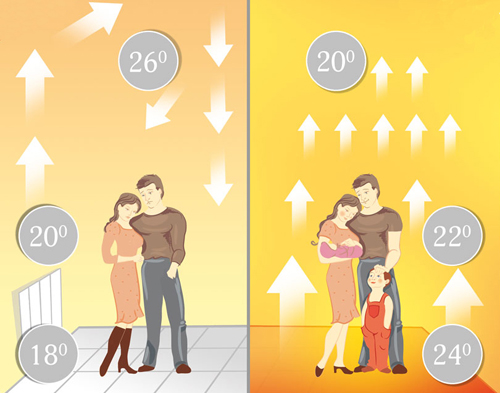
If you install water-heated floors with your own hands, warm air will be distributed successfully throughout the room, starting with the lower layers. The legs are wrapped in the most comfortable heat - 25-30 degrees. In addition, such an invariable influx of warm air from the floor removes us from strong and sudden movements of air.
A warm floor today, no one is surprised, because almost every private house has its own autonomous heat supply system, and the owners plan to install a water-heated floor with their own hands - this is usually already provided for by the project. Of course, in an apartment this is also possible, but it's a little problem. Not every company will allow the reconstruction of the general heating system of the house for the sake of your whims, and installing another self-contained boiler may result in an overhead bill.
The warm floor can be of several types: infrared, film, electric and water. Most inexpensive option is a water, both in terms of maintenance costs and installation costs.
Electric warm floors are a more expensive pleasure because of high energy consumption. With regard to installation, the laying of heating material - the cable - is very simple. A negative feature is the low level of safety in the health of residents of the house of electromagnetic radiation.
When deciding to install a water-heated floor, you will achieve considerable financial savings, thanks to the fact that the room warms up more efficiently, faster and more evenly.
The system of water floors is a pipe made of metal-plastic or polypropylene, which are laid along the contour in accordance with the scheme of the previously developed project; Hot water with the given property and corresponding parameters moves along them. Adjusting the temperature of the water, as well as air in the room is done independently with the help of a room thermostat - this is, perhaps, the most important charm of warm water floors.
Installation of a warm water floor with your own hands
The next advantage of the water floor will be its low power consumption. Unlike electric or infrared heating, the water system significantly reduces the cost of maintaining the system. Here, its cons are revealed: possible leakage (this can happen if the system has been mounted illiterately), complex assembly work (especially for those who make the warm floor themselves), and more ... in order to lay the system, have to raise the floor by about 100 mm.
In addition to the boiler, regulating valves and the pipe circuit, the floor heating system includes a distribution manifold cabinet - it is located on the wall of the room where you plan to install heating with warm floors. In such a cabinet, a return and supply pipeline are set up, which are connected through the overflow valves to the manifold, and also pipes for the heating system, which are connected to the corresponding outlets.
Important! The presence of valves for release from the general air system is mandatory!
Some moments of the instruction that must be taken into account before beginning the laying of pipes:
- Lay the pipes on a previously prepared floor surface. Its base must be even, for this it is allowed to use building self-leveling compounds. If the surface is not even, the heating of the floor will be uneven.
- After finishing the leveling, a layer of waterproofing should be laid on the rough floor.
- The most optimal diameter of metal-plastic pipes is a cross section of 20 mm.
- Each laying loop is made by a single pipe to avoid possible leakage at the joints.
- The thickness of the thermal insulation layer is selected according to the size of the thermal load: the greater the load (temperature), the greater the thickness of the thermal insulation.
- You can not start the system of warm floors until the solution is completely dry (the approximate drying time of the concrete solution is 28 days). Only after this it is possible to switch on the heating system, gradually increasing the temperature of the coolant. Absolutely ready system of water-heated floors will be ready to start working with the selected parameters only after 3 days.
Variants of installation of system of warm floors
There are two options for installing a warm floor: grazing and concrete. In the latter case, the warm floors will have a concrete surface, that is, a screed, and in the first - polystyrene or wooden flooring. A "wet process" is not typical for the flooring method of installing a warm floor system; thanks to this, all installation work is carried out much faster.
However, not all have the means and possibilities to install a water floor, so in this case it is better to hire professional masters. And someone who saves every penny, you have to do it yourself. So, let's begin.
Concrete floor heating system

At the moment concrete flooring installation system – the most popular because of its simplicity. Heating pipes that are laid along the contour are closed with a concrete screed without any heat separators. How is the process carried out?
First, you need to divide the entire area of the heated space into small areas; their number depends on the size of the room (keep the ratio of all sides of the separated sections in a proportion of 1: 2). This is due to the further expansion of the screed when floor heating is connected - under the influence of an increase in the temperature drop in the overall system, the screed will begin to deform, and this must be avoided so that the floor does not begin to crack.
Roughing surface must be covered with a layer of insulation. First you need to clean the surface of the floors, after laying heat insulation material, to avoid heat losses in the floors. Correctly selected and properly laid insulation material will provide you qualitative heating of the floor, and the heat will go up. As a thermal insulation material, polystyrene foam can be used - its layer should be 30-150 mm thick and density 35 kg / m3.
Read about how to choose from the accounts of all the variety of types, textures and colors of modern wallpaper for walls.
Learn how to put a laminate on a wooden floor - a complete instruction for laying the laminate.
The technology of waterproofing the wooden floor in the bathroom is described in the article:
The thickness is selected depending on the characteristics of the room - how much it needs to be heated. And on top of the insulation lay an ordinary polyethylene film, as a waterproofing layer. Then over the entire area of the heated room lay the damper belt. It is necessary to compensate for the thermal expansion of the screed.
Reinforce the insulation layer, and then lay on the contour of the pipe. The usual reinforcement is a grid 150x150, a section of rods up to 5 mm. If you decide to reinforce the screed, then you can lay an additional layer of the grid already after the heating pipes have been laid.
Installation of the pipes of the system
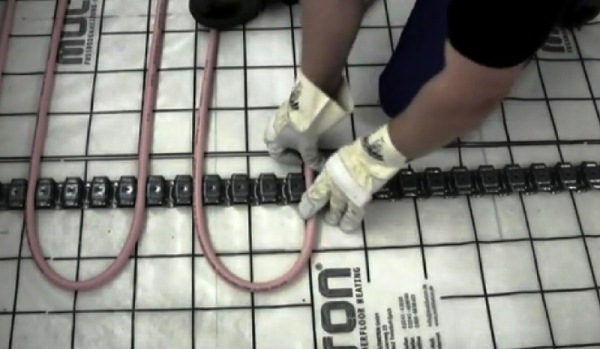
Water heating attachment own hands - not a complicated process. The project is developed according to the preliminary calculation, according to which the pipes are laid. Within a range of 75-300 mm, the step of the tubes should lie, and depending on the geometrical arrangement of the separated sections, a stacking pattern is chosen: a spiral is usual or with a displaced center, a standard or double snake.
The heating elements of the pipes are fixed with clamps to the reinforcing mesh, and in the place of the expansion joint, corrugated pipes are put on pipes in order to protect the pipe against possible damage.
Remember! The length of pipes should not exceed 90 meters, otherwise the heat losses will be much greater, and the pressure of the coolant will fall in the system.
On average, for each square meter there are 5 per m of pipes, with the condition that the pitch between the pipes is 200 mm. The final stage of stacking is crimping. With it, you can identify the existing mechanical damage. Pressurization is carried out at a pressure of 0.4 MPa for at least 24 hours.
At the end of the crimping pouring concrete floor screed. The thickness of the concrete layer should be about 40-70 mm, as a mortar, use M300 sand concrete or a special mixture intended for warm floors.
As for the final finishing of the floor, it is performed after complete hardening of the concrete. As a finishing material, try to choose one that has good thermal conductivity, for example, linoleum, ceramic tile or laminate.
Read about it, and learn the secrets of choosing this flooring and the fineness, worthy of attention when buying.
Videos about the wall covering with panels of MDF can be seen - for those who repair the walls and prefer the video format of training.
The water-heated floor can be used as an independent source of heat and in combination with other types of heating. Errors in the installation of such a heating system can lead to serious consequences, for example, flooding neighbors from the bottom. But knowing the basic principles of stacking, this work can be managed independently.
Types of flooring for underfloor heating
Not all kinds of floor coverings conduct heat equally well. The best indicators of thermal conductivity are ceramic tiles, this parameter is worse for parquet and laminate, and the weakest conducts heat carpet.
Wooden floors dry up as a result of heating, so they are used in systems with a temperature of no higher than 27 ° C. Floor boards should not be wider than 150 mm and not thicker than 16 mm. When choosing a parquet board, preference should be given to the material, not with varnish, but with an oil coating.
In the instructions to most brands of laminate it is indicated that it can not be heated above 30 ° C. And if the temperature of the electric and infra-red floor is regulated quickly enough, the hot water in the pipes can not cool down instantly and is able to spoil the flooring. As a floor covering for underfloor heating systems, it is allowed to use a specialized laminate with good thermal conductivity. The thickness of the layer should not exceed 7 mm, otherwise it will not pass heat easily.
Laying of a warm underfloor under the screed
Before you start laying, you need to prepare the surface. Careful align rough floor: seal the cavities and eliminate the protrusions or use for this purpose bulk floor . The deviation from the horizontal line should not exceed 5 mm over the entire area of the rough surface. Otherwise, the distribution of water in the pipes will be uneven, and because of the air congestion and increased hydraulic resistance, the system will work intermittently or even completely out of order.
The system requires a waterproofing layer, especially if under the overlap is the ground or unheated room. Waterproofing will prevent the penetration of condensate into the heat-insulating material, reducing heat loss.
The most common and inexpensive type of insulating material is a roll film or ruberoid . They are glued to the surface building hair dryer or a burner. This method is used for waterproofing large rooms. In small rooms it is more convenient to use mastic water-based - this type of waterproofing provides better protection against moisture and easier to self-stow. To prevent leakage at the intersections of the damper joint in the screed and connecting the pipe to the manifold, these sections of the water circuit are placed in an insulating corrugation.
To compensate for the thermal expansion and pressure of the screed on the wall as a result of heating, and also to insulate the wall from heat, use damper belt . This material is laid along the perimeter of the room, without missing doorways, columns and other structural elements. With the help of a damper tape, also create deformation joints between the screed sections - they are necessary when laying the floor in a large area or a complex, elongated shape. In this case, several water circuits are used for the individual sections to which the room is divided.
The insulation layer will prevent losses and heat migration to the underlying surfaces, and also create the effect of additional sound insulation. Today, the market has insulation based on mineral fibers or foams, which are available in rolls or plates. For each type of thermal insulation, there are certain installation schemes.
The most commonly used thermal insulation material - expanded polystyrene , which has the properties of polystyrene foam, but is more practical. Expanded polystyrene insulation can be smooth, or have grooves or bosses to facilitate the process of laying and fixing pipes. It is convenient to install insulating material in slabs with already marked markings for the installation of the water circuit. This option is ideal for a sufficient ceiling height, if you want to keep the maximum height of the room is better to choose a foil insulation.
Mineral wool Available in the form of rolls, hard boards or flexible mats. Advantages of this material: fire safety and high heat transfer of the system. A flexible mat is a mineral wool whose surface is covered on one side with a layer of non-combustible perforated paper. This form of insulation is used to insulate the floor in the apartment. Plates made of mineral wool are more rigid and are used for thermal insulation of the floor, which borders on the ground. Today among the heat-insulating materials of this type the most popular - basalt insulation . It is durable, non-flammable and has good soundproofing properties.
For thermal insulation of the warm floor is used and cork insulation , which has high strength and soundproof characteristics.
Ways of laying
There are several popular ways of styling water floor : spiral, "snake" and "double snake". Spiral laying of pipes is most effective - with this arrangement, the warm floor is warmed evenly due to the alternation of the turns of the pipe with hot and cold water. In the "snake" as the distance from the collector, the temperature of the coolant becomes lower. Double "snake" is able to slightly compensate for the temperature drop, but it is very laborious in mounting.
When laying water circuit "Snake" must be remembered that the difference in temperature between the inlet and outlet should not exceed 5 ° C. If this is not taken into account, in the areas remote from the collector the floor will remain cold. To control the temperature, it is recommended to install sensors: one after the pump at the entrance to the system, the other before the pump at the outlet. Efficiency and efficiency of the system is checked before the screed is poured - during the test run, it is possible to identify the defects that are allowed during installation.
Between the pipe and the floor surface a small gap is required. The water circuit is fixed to reinforcing mesh with help clamps , clips or fixing straps. Many manufacturers offer convenient solutions for installation, for example, a stapler with staples, which securely fix the pipes on the substrate substrate.
Using relief mats with grooves and latches makes installation much easier, installation of a warm floor on such a base does not require the use of special tools and tools.
The distance between the pipes should be 10 - 30 cm. If the floor is the only source of heating, select the minimum value. The laying step is shortened at the outer walls.
It is important to make a correct calculation of the number of water circuits and their length: each of them must remain integral and do not have connections inside the floor. The maximum length of one pipe must not exceed the values obtained in the calculations. This parameter depends on its diameter: the tube is thicker, the less the hydraulic resistance in it, and consequently the length of the contour can be larger.
Choice of coolant
To fill the system of the warm floor use the same coolant as for radiator heating - water and aqueous solutions based on propylene glycol and ethylene glycol with additives.
What are the advantages of conventional or distilled water used as a coolant? First, the price. Secondly, environmental safety. Thirdly, a sufficiently high heat capacity and the possibility of use in any type of heating system. One of the most serious drawbacks of water as a coolant is the possibility of freezing at low temperatures, when the whole system can be out of order. The second significant negative is the corrosive effect on the metal parts of the system. This problem is solved using materials with low oxygen permeability. For example, pipes made of cross-linked polyethylene with an oxygen-barrier barrier are resistant to corrosion and deposits, as well as to abrasive and mechanical wear. Unlike antifreezes, which require replacement every 3 to 5 years, water in the underfloor heating system must be changed at least once a year.
Low price and ability to freeze only at very low temperatures - the main advantages of antifreeze based on ethylene glycol. Additives can compensate for the deficiencies of this liquid: corrosion activity, fluidity, high degree of foaming. Ethylene glycol is extremely toxic and can cause severe poisoning. It is allowed to use only because the water-heated floor is a closed system.
Liquids based on propylene glycol have a low freezing point and little corrosive activity. This option is more expensive than the others, but also more environmentally friendly and safe. The use of ethylene glycol antifreeze is justified if the winter is very cold.
Collector for water floor
Collector are connected to a system of a warm floor in order to distribute a constant-temperature coolant to each water circuit and collect the cooled liquid. The simplest type of collector is a pipe with several threaded holes for connection. To use this option for a warm floor, you will have to buy a lot of additional parts.
Collectors with ball valves on the outputs have a significant drawback - they can begin to leak after a while after the start of operation. In addition, such models can not be supplemented with automatic devices for adjusting the temperature in the system.
There are also collectors with control valves, to which you can connect servos to control the amount of coolant in the pipes.
There are also collectors with flowmeters on the supply manifold and servo jacks on the return. Such devices are designed for systems with different lengths of water circuits: with the help of a flowmeter it is easy to adjust the flow of the heat carrier, which is fed to each circuit.
Adjusting the temperature of the warm floor
The temperature of the warm floor and, accordingly, of the air in the room is set thermoregulator with a remote sensor, which is installed inside before pouring the concrete screed. The sensor is connected to the thermostat, which in turn instructs the servo to turn the tap to increase or decrease the flow of the coolant to a specific water circuit.
It is possible to manually and automatically control the underfloor heating system. A manual thermostat is a thermostatic head that rotates to set the desired temperature. Such devices are inexpensive, easy to install, but in the process of operation require constant human intervention. The presence of the automatic control device greatly facilitates the control of the underfloor heating system.
The electronic thermostat is a control unit with an integrated air temperature sensor, with which you can set the desired temperature. The simplest version is a box with a handle for selecting the temperature, devices are more complicated - radio-controlled, touch and programmable temperature controllers. Using the programmable device, you can not only set the room temperature, but also choose modes of saving energy or increased heating, set the time to maintain the temperature, its maximum value and other parameters.
A reference article based on the expert's opinion.
In your own home - pleasure is not cheap. Like other types of engineering equipment, the heating system is installed in earnest and for a long time. The heating boiler, its piping, automatic control can eventually be improved or replaced. Communications located hidden, including pipelines, will last at least half a century. You need to do these works in the best way.
At a minimum, the landlord must understand what the equipment supplier offers and what the plumbers do. As a maximum, he can do the work himself, saving a considerable amount. Without the skill, it is not necessary to undertake the installation of a boiler room, but how to lay a warm water floor can be sorted out independently.
Project - why is it needed?
Heat engineering is an exact science. The right solution is to order a specialist for the project of a water heating system. If you buy most of the equipment in one place, a decent company will perform it for free. If you order a project separately, it will cost from 2000 rubles and higher.
The designer will accurately calculate all the heat loss of your house, make a rational scheme of communications, pick up the appropriate equipment. The scheme will include all the necessary solutions to create the necessary thermal comfort and economical fuel consumption. A qualified engineer will be able to provide the best combination of comfort / economy / price.
In the part of the warm floor in the project does not have to think, how to lay a warm water floor: will be detailed schemes for laying and connecting pipelines with the required geometric dimensions, specification of materials.
If you still work without a project, you should understand a few key points.
How to lay a warm water floor in the house yourself?
Device
The water-heated floor has the following structure:
- Contours. Heating individual zones provide separate pipelines, through which the coolant circulates. They are located in a layer of concrete or a cement-sand mortar with a thickness of approximately 5 cm. To heat energy transferred into the room, rather than leaving the ground or overlap, a layer of insulation is placed at the bottom. The pipe in each of the circuits must be integral, the connections are inadmissible.
- Collector (comb). All contours on the floor are connected to one collector. In it there are two comb-distributors: feeding and return.
- . Since the temperature of the coolant should not rise above 40 ° C (in batteries it is often larger), a mixing unit is located at the inlet of the collector, mixing with the hot liquid from the supply line cooled from the return line.
- To ensure proper circulation of the coolant, a collector is installed pump.
- Control. Automatic or manual regulators are installed on the mixing unit and each of the circuits.



Hydraulic resistance and contour length
The hydraulic resistance that occurs when the coolant flows through the pipes should not be too high, otherwise standard pumping equipment will not be able to effectively "squeeze" the liquid. The longer the length of the pipe, the higher the resistance. It is recommended not to exceed the value of 120 m. Making the contour too short is also unprofitable, costs are unjustifiably increased.
The optimum (economical and effective) contour length is 80 m.
Different contours, located on the same comb, should have a similar hydraulic resistance. Otherwise, they will be difficult or impossible to balance.
The difference in the length of the pipes of individual circuits should not be more than 20% and exceed 15 m.
Stacking patterns
To lay a warm water floor in a separate circuit, you can in two ways: a snake and a spiral
When laying snake the pipe is located sequentially-parallel, like strips on a vest. The disadvantage of this scheme in the uneven distribution of temperature: where the coolant enters the circuit, heat. Closer to the exit the floor cools noticeably. Improved double snake partially solves this problem.
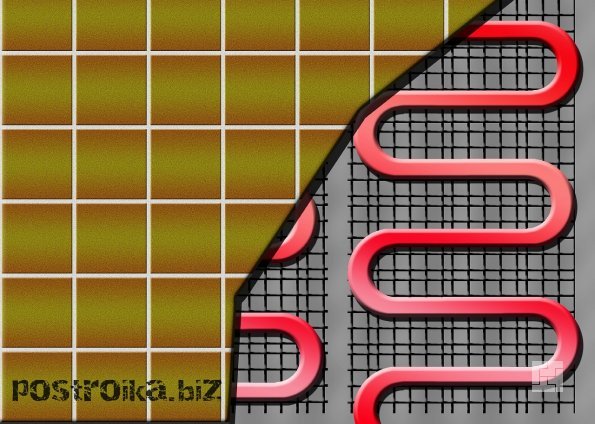
When laying coil the question of the uneven distribution of heat is not worth it: the supply and return pipes alternate, are located in each coil alongside, mutually balancing the temperature difference. In rooms with large windows, a double snake is used to compensate for heat loss. First, closer to the stained glass, lay the first spiral, which will be warmer due to the fact that the feed is connected to it. Then, without interrupting the contour, a second meander is laid, which will be heated to a lesser extent. Laying pipes with a spiral is more time consuming, but it allows to provide higher thermal comfort and is used more often.
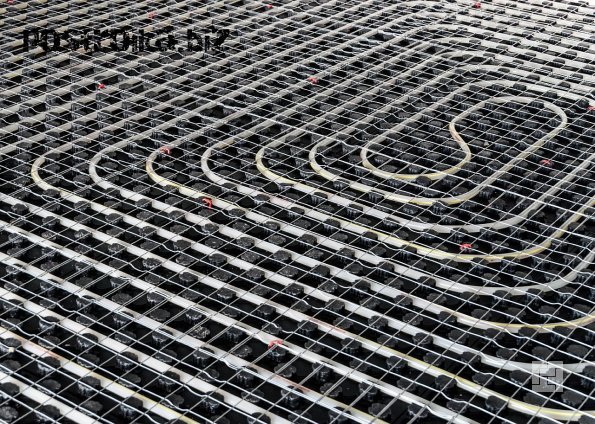
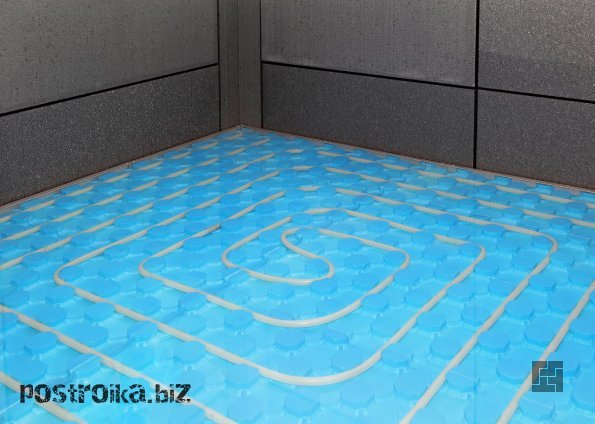
Distance between pipes
The pitch between the pipes is determined by heat engineering calculation. To the outer walls the distance is reduced, further from the cold areas increase. The optimum is 15 cm, closer than 10 cm of the pipe is not recommended. On bends, the bend radius should not be less than 5 diameters.
In practice, for the central zone of Russia, the pitch of pipes with fully floor heating in the house is on the average 10-15 cm, when combined with radiators - 15-20.
Pipes
Widely distributed two options: metal-plastic and polyethylene PE-X pipe. Metal plastic is more plastic and therefore more convenient for layout. However, during the pouring of concrete, it will have to be handled with care, unlike polyethylene. There is no significant difference in properties, durability and price between them.
Heater
It is necessary to insulate the heating structure of the floor from the bottom. When choosing a heater there are two limitations: it must be hydrophobic (do not absorb moisture) and hard. Excellent results give application foam glass and extruded polystyrene foam. They also use high-density foams PSB-35 and PSB-50. Above the first reinforce the metal netting concrete screed necessarily, the second - it is desirable.
The minimum thickness of insulation for floors on the ground should be 10 cm, overlapping - 50 cm. Better - more economical will be spent fuel.
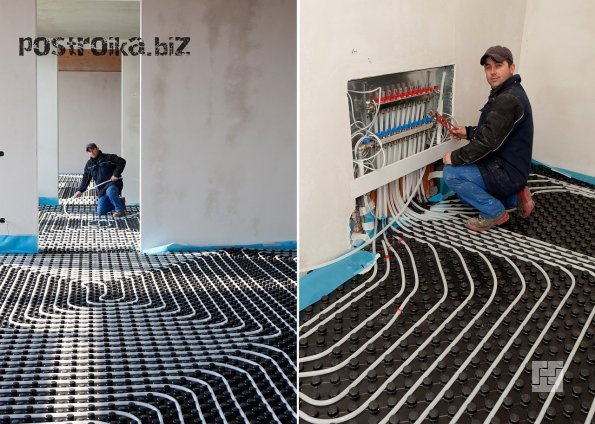

We mount the building structure and lay the pipelines: how to lay a warm water floor correctly
- We order the project or independently draw up a scheme, determining the location of the contours and the location for the collector. To him must come all lead and lead pipes, carts from the main risers. It is necessary to lead to it and power supply. The collector can be located in a standard plumbing cupboard.
- We prepare the base, if necessary, we do. We stack the heater. In addition to flat ones, polystyrene plates with one side on the whole surface are sold protuberances-"umbilicals". Laying pipes between them is much easier than on a flat base. If you choose a cheaper insulation with an even surface, it should be additionally closed from the top foil or foil-foamed polyethylene. On the perimeter of the premises it is necessary to build damper belt, more often it is a strip of foamed polyethylene.
- Lay out the contour. How to lay a warm water floor on a flat heater? It is necessary to strengthen. In extruded styrofoam with anchor clips. Foam glass with dowels and plastic (not wire) clamps. When installing on a foam, it is convenient to tie the pipes to the reinforcing mesh. We collect the collector.
- Have we put the concrete part of the floor. Concreting should be tried to complete in one shift, so that no stitches remain. The optimum layer of concrete or mortar above the pipes - 35 mm. To avoid cracks, the screed must be divided to the full height by strain seams that coincide with the boundaries of the contours. The maximum distance between the seams - 9 m, the maximum permissible area of the "solid" section - 40 m2. The seams are cut in ready-made concrete or formed when laying the mixture, inserting a damping tape with a width of at least 6 mm. During the laying of concrete, the pipes must be filled with liquid or compressed air under operating pressure.
- We make the screed material with high heat transfer: ceramic or stone tiles.
It is possible to switch on the heating (to supply a coolant with a temperature above 25 ° C) only three weeks after the manufacture of the screed, not before.
Now we know, how to lay a warm water floor yourself. The task as a whole is not very difficult, especially if there is a project. Being accurate and observing the basic rules, even a "kettle" will cope with it. With a lack of experience for assembling the collector and even more so the boiler room and control systems it is better to invite specialists.
